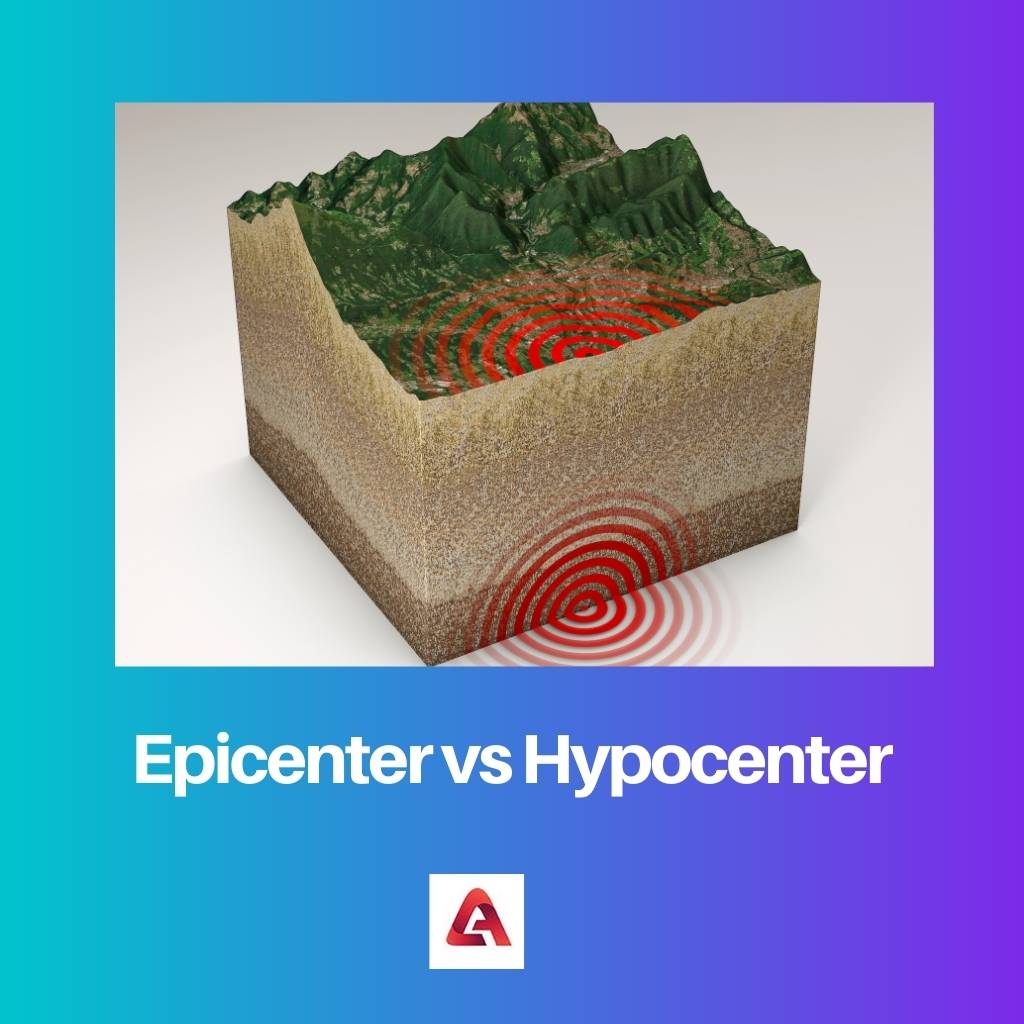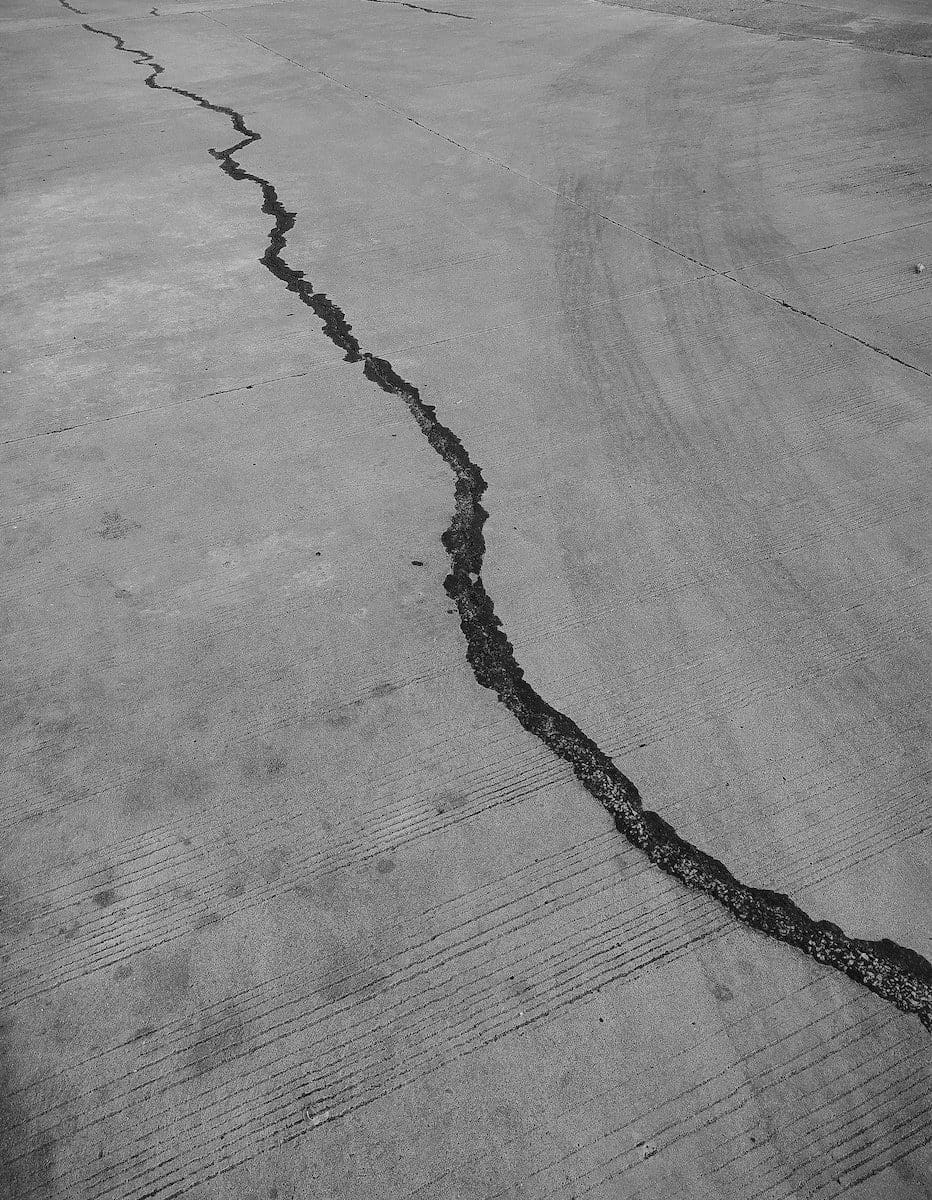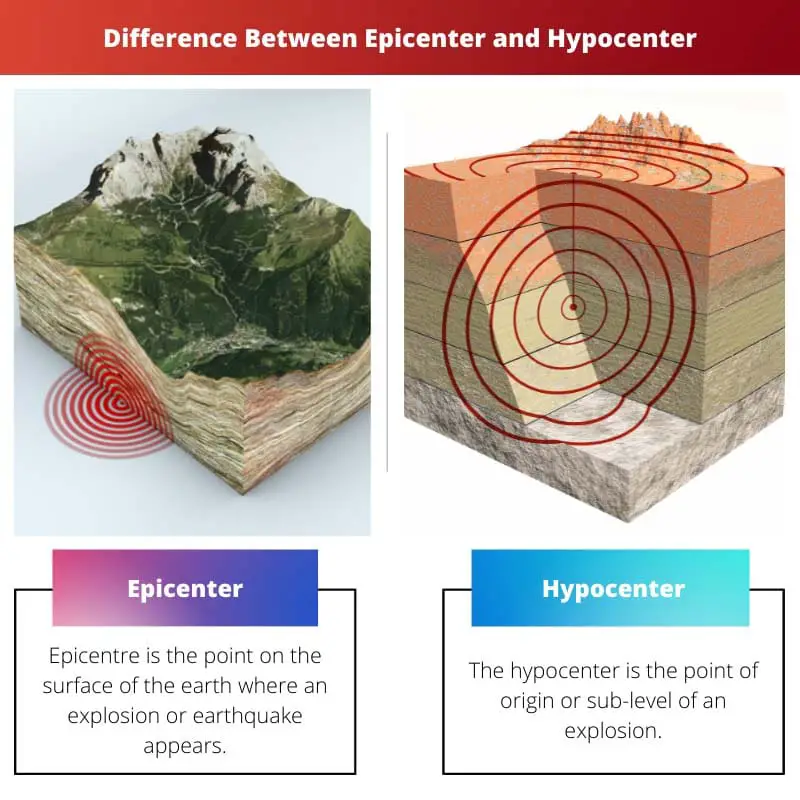Earthquake a phenomenon that causes seismic waves and can be natural or caused by humans. At the surface of the Earth, it can be recognized when there is a sudden shaking, displacing or disruption of the ground.
Key Takeaways
- The epicenter is the point on the Earth’s surface directly above the point of origin of an earthquake, while the hypocenter is the point within the Earth’s crust where the earthquake originates.
- The epicenter is where the earthquake is most strongly felt and where most damage occurs, while the hypocenter is deeper underground and can be more difficult to pinpoint.
- The distance between the epicenter and the hypocenter can provide information about the size and intensity of the earthquake, with larger distances indicating a more severe earthquake.
Epicentre vs Hypocenter
Epicentre appears on or above the surface of the Earth, whereas Hypocenter appears beneath the surface of the Earth. The waves emitted from Epicentre are both body and surface waves, while those emitted from Hypocenter are only body waves.

It is the focal point examined and researched by seismologists to comprehend the aftereffect and transmission of earthquakes. It is suggested that the most damages are caused at the epicentre.
Hypocenter can be tens to thousands of km deep underneath the surface. As the altitude of the hypocenter increases, the rocks become flaky and ductile.
Comparison Table
| Parameters of Comparison | Epicentre | Hypocenter |
|---|---|---|
| Definition | Epicentre is the earth’s surface point where an explosion or earthquake appears. | The hypocenter is the point of origin or sub-level of an explosion. |
| Position | It appears on or above Earth. | It appears on the sub-level or underground of Earth. |
| Waves | It causes both body and surface waves. | It causes only body waves. |
| Dimension | It measures the 2-D (D stands for dimensional) effect on how there is a spread of the waves. | It measures the 3-D effect on the spread of the waves. |
| Other Names | Also known as Focal Point or Epicentrum. | The name Focus or Ground Zero also knows her. |
What is Epicenter?
Epicentre is called the ‘centre of activity of the earthquake. The focal depth of an earthquake appearing at the crust can range from 2 to 20 km.
Two divisions of waves are emitted by the epicentre of an earthquake, i.e. body waves and surface waves. Body waves get detected from the epicentre.
The waves get their names because S-waves come after the p-waves. The distance of the epicentre is also used to calculate the seismic magnitude, as developed by Richter and Gutenberg.

What is Hypocenter?
A hypocenter is a cradle or birthplace where an earthquake occurs. Also known as focus or ground zero, the nuclear explosion (earthquake) occurs just beneath the ground.
Hypocenters of earthquakes can be ten to hundred or even spread across thousands of kilometres below the earth’s surface. The more the depth will be of the hypocenter earthquake, will increase the rocks around it become soft and pliable, i.e. easily movable.
Because of the impact of an earthquake on the same area over the years, the rocks and stones underground will become so tender that if there is any other earthquake at the same hypocenter, it will not be much dangerous. The power and vigour of an earthquake depend on the pressure built on the poignant and harshness of rock before they break.

Main Differences Between Epicenter and Hypocenter
- Epicentre is the earth’s surface point where an explosion or earthquake appears. The hypocenter is the point of origin or sub-level of a blast.
- The epicentre of an earthquake is on or above the surface of the Earth. The Hypocentre of an earthquake is always on the sub-level or underground in the Earth.

- https://www.researchgate.net/profile/George_Daglish/publication/268447910_An_Algorithm_for_Concurrent_Location_of_Earthquake_Epi-and_Hypocentres_Using_P-Arrivals_in_an_Interpolative_Tabular_Scan/links/546bb8380cf20dedafd53744.pdf
- https://academic.oup.com/gji/article-abstract/209/1/453/2931730

Learning about the epicenter and hypocenter through this article was undoubtedly enlightening. The explanation was clear and concise, providing a deep understanding of this scientific phenomenon.
You’re right! The article’s presentation of scientific concepts and comparisons was both enlightening and engaging.
The comparison and contrast between Epicenter and Hypocenter are intellectually stimulating. The explanation was thorough and provided a nuanced understanding of the seismic occurrences.
Absolutely! The post did a commendable job of presenting these scientific concepts in a clear and intriguing manner.
The emphasis on the seismic waves and the impact on different parts of the earth was very well detailed and intriguing in this article. The details about the impact on the rocks with depth were particularly important.
I found the explanations fascinating and thought-provoking as well. It deepened my understanding of the topic.
I must say, after reading this post, I feel like I came out more knowledgeable about earthquakes. The focus on the main differences between Epicenter and Hypocenter was intellectually stimulating.
This article could be more informative, and some aspects could be further explored in depth. The details seem insufficient to form a comprehensive understanding of the topic.
The article provided a compelling and insightful explanation about Epicenter and Hypocenter. It was quite fascinating how the power and vigour of an earthquake depend on the pressure built on the poignant and harshness of rock before they break.
I completely agree with both of you. The depth of information provided was intellectually enriching.
Indeed! The detailed focus on this aspect was thought-provoking and educational.
This article did a really good job of explaining the difference and importance of focusing on the epicenter and hypocenter of an earthquake. The comparison table was compelling and engaging for the reader. The references provided are evidence of well-researched information.
I agree with you, Naomi. It was very informative and insightful. The comparison table was indeed a great idea.
The detailed explanation of seismic activities was enthralling to read. However, the information provided could be more engaging and captivating.
The article was certainly informative, but integrating a more captivating approach could enhance the reader’s experience.
I agree with your viewpoint, Kkelly. While the content was informative, it lacked a certain engaging quality.
The post indeed provides valuable insights into earthquake phenomena. The comparison between the two focal points was well-articulated, generating an engrossing narrative.
It was indeed a compelling exposition of the seismic occurrences. The focus on Epicenter and Hypocenter provided a thorough understanding of their significance.
The scientific focus of the article was intellectually stimulating and informative. The detailed comparisons and elaborations provided for a comprehensive understanding of the earthquake phenomena.
Absolutely! The in-depth information and detailed comparisons were highly enriching for readers.
This article provided valuable insights into the comparison between Epicenter and Hypocenter. The focus on the main differences was quite enriching.
I found the details about the waves emitted and their impact particularly engrossing. The article was well-composed and informative.
I feel like the content was thought-provoking, especially in its emphasis on seismic magnitude calculation using the distance of the epicenter.